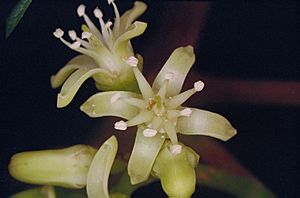Acronychia acronychioides facts for kids
Quick facts for kids Acronychia acronychioides |
|
|---|---|
 |
|
| Scientific classification | |
| Genus: |
Acronychia
|
| Species: |
acronychioides
|
| Synonyms | |
|
|
Acronychia acronychioides, often called white aspen, is a special kind of tree. It grows naturally only in the rainforests of north-eastern Queensland, Australia. This tree is known for its interesting leaves and creamy yellow flowers. It also produces small, fleshy fruits.
Contents
What Does White Aspen Look Like?
The white aspen is a tree that can grow quite tall, up to 25 meters (about 82 feet). Its main stems are usually round.
Leaves and Flowers
- The leaves are usually made up of three leaflets, like a clover. This is called trifoliate.
- Each leaflet is shaped like an ellipse or an egg, narrower at the base.
- They can be 70 to 210 millimeters (about 3 to 8 inches) long and 20 to 65 millimeters (about 1 to 2.5 inches) wide.
- The flowers are creamy yellow and grow in large groups. These groups are found where the leaves meet the stem.
- Each flower has four small leaf-like parts called sepals and four petals.
- It also has eight stamens, which are the parts that produce pollen.
- White aspen trees usually flower from April to May.
Fruit
- After flowering, the tree produces a fleshy fruit.
- This fruit is shaped like a pear or a sphere (a ball).
- It is about 8 to 13 millimeters (about 0.3 to 0.5 inches) long. This type of fruit is called a drupe, like a peach or a cherry.
How It Got Its Name
The white aspen was first described by a scientist named Ferdinand von Mueller in 1864. He gave it the name Euodia acronychioides. Later, in 1974, another scientist, Thomas Gordon Hartley, changed its name to Acronychia acronychioides. This is the name it still has today.
Where White Aspen Lives
This tree grows in the thick rainforests of Queensland, Australia. You can find it from the Tozer Range in the north-east down to the Eungella Range in central eastern Queensland. It grows from sea level all the way up to 1,200 meters (about 3,900 feet) high in the mountains. It often grows as an understorey tree, meaning it lives under the canopy of taller trees in the forest.
Is White Aspen Safe?
The Queensland Government has a law called the Nature Conservation Act 1992. Under this law, the white aspen is classified as being of "least concern." This means that there are enough of these trees in the wild, and they are not currently at risk of disappearing.


